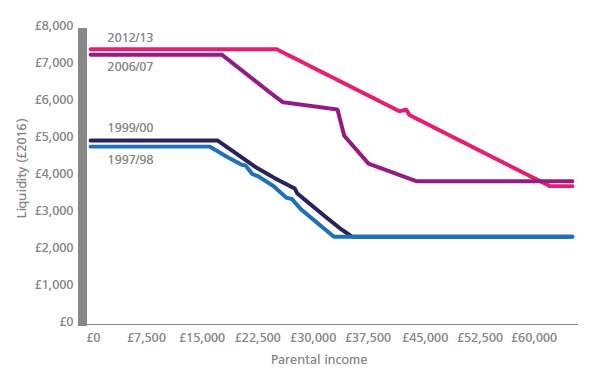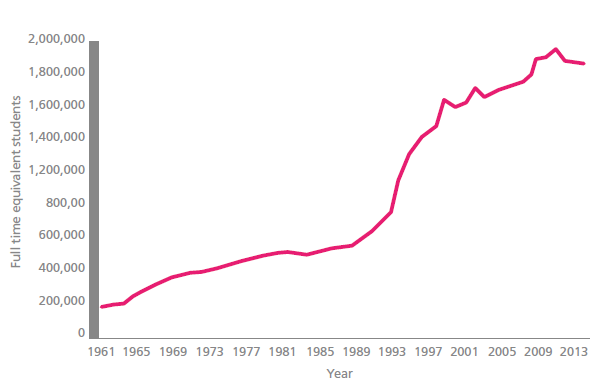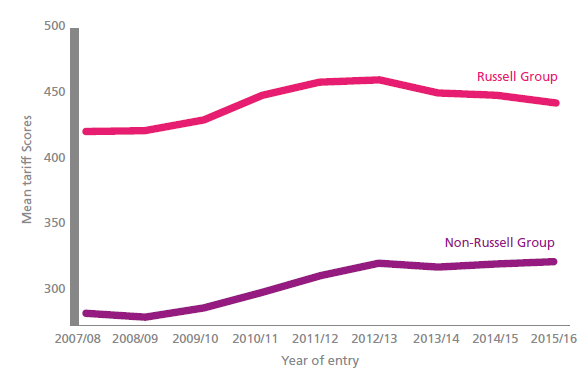
The UK has a world-leading university sector and this has a key role to play in moving the country onto an inclusive and sustainable growth path. Universities can make important contributions across the five foundations that underpin the government’s industrial strategy:
- Universities support the productivity and prospects for ‘people’ through the education of students and the nurturing of researchers.
- Via their research activity, universities generate innovation or ‘ideas’ that create spillovers for businesses in the economy.
- There is a strong element of ‘place’ as universities have an impact on their local economies via the production of human capital and innovation, and by other forms of interaction with local industry.
- Universities therefore affect the ‘business environment’ implicitly via these mechanisms; they can also affect it explicitly through schemes such as university incubators.
- Finally, universities have a role in producing the innovation required to underpin modern, resilient and sustainable ‘infrastructure’ across the country.
Moreover, the research conducted in universities, in many cases in collaboration with businesses, will be crucial for addressing the four ‘grand challenges’ of artificial intelligence and the data economy, clean growth, the future of mobility and an ageing society.
While few would dispute the potential contribution of universities in all these areas, it is less clear how this can be maximised. The sector has witnessed a number of reforms in recent years, and there is much debate about future policy, in particular with respect to its financing and accessibility, expansion, globalisation and economic impact. Today, universities also face considerable uncertainty arising from the potential effects of Brexit.
Tuition fees, admissions processes and accessibility
Matching workers to jobs that make best use of their talents is a key driver of productivity and growth. Therefore, allowing young people from all backgrounds to realise their potential is important not just on equity grounds and for improving social mobility, but also in terms of improving the UK’s overall economic performance. In recent years, there have been substantial improvements in university participation among students from disadvantaged backgrounds.
But there remains a significant gap between disadvantaged students and their advantaged peers, particularly at the most selective universities. Figures from UCAS, the Universities and Colleges Admissions Service, show that the most advantaged applicants are six times more likely to enter higher quality institutions compared with the most disadvantaged.
The participation gap is driven primarily by prior attainment, but even when this is taken into account, state school students are still significantly under-represented at leading universities. The real or perceived cost of university to the students and their families, and the admissions process itself are likely to be explanatory factors.
University finance has become one of the most hotly debated public policies of recent times, following a number of reforms including the introduction of fees (in 1998), subsequent increases (in 2006 and 2012) and the conversion of university maintenance grants to loans (in 2016).
Despite the controversy, research finds little impact of these reforms on the enrolment rates of students from different socio-economic backgrounds, including those from more disadvantaged backgrounds. The design of the payment system might explain this. Although all students were obliged to pay tuition fees from 2006 onwards, there was progressivity in upfront costs through increases in means-tested grants.
Figure 1. Net liquidity (grants plus maintenance loans – upfront fees) by parental income and fee regime

Notes: Based on analysis in Murphy et al, (2017) using data from Student Loans Company, 1991-2015. Figures expressed as amounts per year. The unweighted average liquidity for students between £0 and £60,000 parental income was 1987/88: £3,321; 1999/2000: £3,430; 2006/07: £5,520; and 2012/13: £6,241.
Moreover, there was a release in financing constraints with access to additional loans and protection against personal bankruptcy due to student loans. Figure 1 shows, by parental income, that students experienced an increase in liquidity over time.
It is still too early to assess the impact of the conversion of maintenance grants to loans, but this policy is regressive by its nature, as it implies that students from poor backgrounds will now graduate with higher debt. Therefore, it is important to consider how to mitigate any potential negative effects (for example, through strengthening careers services and information provision for those likely to be affected).
The evidence suggests that a number of features of the UK university admissions system might be putting students from poorer backgrounds at a disadvantage, leading them to make sub-optimal choices and to end up at institutions that are less selective than they could attend based on their grades. Better information is likely to help to address this, but research suggests that this is more likely to be effective if it is individually tailored and targeted.
Figure 2. Full-time equivalent (FTE) enrolments over time

Notes: Statistics for 1961-2002 are taken from Carpentier (2004) and Statistics for 2002-2014 from Higher Education Information Database for Institutions. FTE enrolments contain all student types (full-time, part-time, postgraduate, undergraduate, UK, EU, overseas); increase in 1994 is partly due to students entering higher education from former polytechnics.
Expansion of the university sector: quality versus quantity?
University enrolments have expanded considerably in the UK since the 1960s (see Figure 2), including during the period covering the introduction of and increases in fees. Recent evidence suggests that this growth may be slowing, with enrolments down slightly over the past two years, driven by falls in students from both the UK and the European Union (EU), particularly older students. Nevertheless participation is at record levels, with 49.3% of 17-30 year olds participating in higher education.
Current policy aims to continue this expansion: controls on student numbers were completely removed in 2015, and the government is also keen to encourage new entrants to the sector. It remains to be seen whether these moves will generate further expansion, though early analysis shows an increased offer rate, as well as falling entry grades among Russell Group institutions (see Figure 3).
Figure 3. Average entry tariff scores by university type

Notes: Weighted average of student entry qualifications. For A-levels, the points are A* 140, A 120, …E 40. For AS-levels, the points are A* 70, A 60…. E 20. All qualifications are counted, even those that are not part of the entry requirement, for example, General Studies and AS-levels in unrequired subjects.
The impact of university expansion on quality is a question that has been raised since the Robbins Report in 1963, when one in 100 students went to university. It remains a concern today, with fears of an over-supply of students, and graduates ending up in low-skilled jobs.
The latest analysis suggests that these fears have yet to materialise. Labour market returns to degrees remain strong on average. But recent evidence points to considerable variation in earnings, with some subjects (such as law and economics) providing high returns (particularly if studied at certain institutions) and some (such as the creative arts) perhaps more of a risky bet in terms of future wages.
To alleviate these concerns, the government has made moves towards further monitoring of quality. The new Teaching Excellence Framework has been criticised for failing to capture adequately what goes on in lecture rooms. And moves to link this to tuition fees were blocked by the House of Lords, putting the brakes on a key government strategy.
Other moves to regulate quality (for example, the new Office for Students) are at too early a stage to be assessed. But in the absence of externally marked degrees or a system of testing that is applicable to all universities and courses, it is likely that assuring quality at university will continue to be a tough nut to crack.
Universities and international talent
Recent years have seen increased internationalisation of higher education systems across the globe, both in terms of students and academic staff. Almost one in five students in the UK higher education system comes from overseas, and of these, 30% are from the EU. Currently, EU students are treated in the same way as UK nationals in terms of tuition fees and access to government-funded student loans, but after Brexit, this is unlikely to be the case.
The evidence suggests that increased costs will induce a fall in demand, leading either to a reduction in tuition fee income (and therefore reduced resources to be spent on students) or a reduction in the quality of students admitted to courses (to fill the spare capacity).
A fall in the number of EU students after Brexit will also lead to a fall in the non-academic benefits that they bring to the domestic economy, via spending on goods and services while at university, and their propensity to work in the UK and contribute to the economy after graduation. There are also anticipated negative effects on the ability of the UK to attract and retain academic staff from the EU, and access international research collaboration or funding.
Ultimately, the impact of Brexit on UK universities will depend directly on government policy. Will research funding currently available through the EU be matched by the UK after Brexit? Will international collaborations be fostered? Will students and faculty count towards immigration targets? Will there be continued financial support for EU students?
The answers to these questions will have large effects on the productivity and efficiency of the sector, and the wider economy.
Universities and their local economies
Universities have an important role in national and regional growth strategies worldwide, as producers of graduates (human capital) and innovation, both key inputs into economic growth. Since the 1990s, in the UK and overseas, there has also been increased focus on the so-called ‘third mission’ of universities, giving them an explicit role in socio-economic development.
Based on international data on regional economic growth, it has been shown that an increase in the number of universities in a region is robustly associated with higher GDP. Analysis based on UK universities finds that growth in enrolments appears to generate start-up activity in nearby areas, including in the innovative high-tech sectors.
The evidence on the continued wage premium for graduates suggests that expansion of the university sector will continue to generate valued human capital, assuming that quality is maintained. But there are more challenges: employers consistently report skills gaps in areas such as languages and STEM (science, technology, engineering and mathematics); and rapid technological change will give rise to new skill demands, and a need for upskilling the workforce. Universities (and further education colleges) will need to play an important role here.
The government recently pledged to raise publicly financed research and development (R&D) over the coming years (this has lagged other advanced economies as a share of GDP for some time – see Figure 4). Increased funding for university R&D is good news as this research generates innovation, and also creates spillovers for firms.
Figure 4. Government-financed R&D as a share of GDP

Notes: Government-financed GERD (gross expenditure on R&D) as a percentage of GDP, sourced from OECD MSTI.
A number of mechanisms, institutions and government schemes seek to maximise these spillovers through support for collaboration, knowledge exchange and technology transfer. In addition, the most recent assessments of research quality are placing increased emphasis on impact.
Also in development is a new knowledge exchange framework to benchmark universities’ performance in knowledge exchange and commercialisation. While all these efforts are needed, they should not all be solely focused on the supply side (universities). There could be scope for providing explicit support for business-university research collaboration within the R&D tax credit system (a mechanism that has been shown to be effective in stimulating demand for R&D among smaller firms).
Moreover, in addition to generating and growing innovation hubs that boost firms at the technological frontier, there is potential for universities to play more of a role in the diffusion of existing technologies or organisational practices via targeted business support programmes, thereby increasing the productivity of lagging firms (particularly small and medium-sized enterprises), which are a drag on UK productivity. But there is little evidence on the impact of university business support activities where they do occur. New schemes and policies, particularly those involving government support, should be designed with evaluation in mind.
Conclusions
The UK’s university sector is a source of national strength and it has the potential to contribute to all areas of the government’s industrial strategy. To ensure that young people in the UK are able to realise their productive potential, it is important to improve the accessibility of the university system for poorer students, and to address variability in the quality of teaching (particularly as the sector expands).
Financing reforms to date have not harmed accessibility, but a fairer maintenance system together with better information and advice for prospective applicants could help close the participation gap. Universities are a core part of the UK’s innovation infrastructure, but more can be done to improve the commercialisation of research, and the diffusion of existing technologies.
Finally, UK universities must remain open to talented international students and staff, who make a key contribution to the quality of the sector and its potential impact.
♣♣♣
Notes:
- This blog post appeared originally on CentrePiece, the magazine of LSE’s Centre for Economic Performance (CEP). It summarises the authors’ paper ‘Universities and Industrial Strategy in the UK: Review of Evidence and Implications for Policy’, CEP Industrial Strategy Paper No. 6
- The post gives the views of its authors, not the position of the institutions they represent, LSE Business Review or the London School of Economics.
- Featured image credit: Photo by Mark Hillary, under a CC-BY-2.0 licence
- When you leave a comment, you’re agreeing to our Comment Policy.
 Ghazala Azmat is a Professor of Economics at the department of Economics in Sciences Po, Paris and a Research Associate at the Centre for Economic Performance (LSE). Her main research interests are in applied and empirical microeconomics. In particular, her research focuses on topics in labour, education and public economics.
Ghazala Azmat is a Professor of Economics at the department of Economics in Sciences Po, Paris and a Research Associate at the Centre for Economic Performance (LSE). Her main research interests are in applied and empirical microeconomics. In particular, her research focuses on topics in labour, education and public economics.
 Richard Murphy is an assistant professor at the University of Texas at Austin and a research associate in CEP’s education and skills programme. He is currently researching the long run impact of where students rank amongst their primary school class mates on their longer run outcomes. He finds that being highly ranked has large impacts on later test scores and non-cognitive skills. Another research area concerns the consequences of an increasingly litigious society on labour markets.
Richard Murphy is an assistant professor at the University of Texas at Austin and a research associate in CEP’s education and skills programme. He is currently researching the long run impact of where students rank amongst their primary school class mates on their longer run outcomes. He finds that being highly ranked has large impacts on later test scores and non-cognitive skills. Another research area concerns the consequences of an increasingly litigious society on labour markets.
 Anna Valero is ESRC Innovation Fellow at the CEP. Her research is focused on the drivers of productivity and innovation, and in particular the role of skills and universities in explaining differences in economic performance between firms and regions. Anna has also been working on UK productivity and industrial strategy more broadly, and in 2017 was a research director for the LSE Growth Commission
Anna Valero is ESRC Innovation Fellow at the CEP. Her research is focused on the drivers of productivity and innovation, and in particular the role of skills and universities in explaining differences in economic performance between firms and regions. Anna has also been working on UK productivity and industrial strategy more broadly, and in 2017 was a research director for the LSE Growth Commission
 Gill Wyness is a lecturer in economics of education at UCL’s Institute of Education and a research associate in CEP’s education and skills programme. Her main research area is the economics of higher education in the UK. She is currently working on a project investigating the impact of university bursaries on completion and performance using a unique data set collected from UK universities.
Gill Wyness is a lecturer in economics of education at UCL’s Institute of Education and a research associate in CEP’s education and skills programme. Her main research area is the economics of higher education in the UK. She is currently working on a project investigating the impact of university bursaries on completion and performance using a unique data set collected from UK universities.





